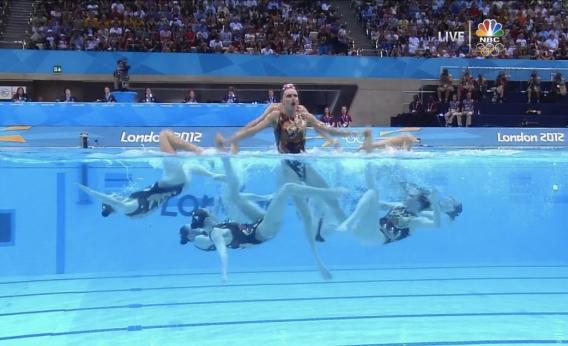Synchronized swimming has never looked so good. As I watched the Russians crush the competition, I also marveled at NBC’s split-screen shots, which simultaneously showed the swimmers’ torsos above water and their legs below it. This perspective came courtesy of the Twinscam, which was invented by Japanese broadcaster NHK in 2010. It’s a solution to a common problem in the Olympic water events: Because of the way light refracts and reflects differently above and below water, we’ve only been able to see shots that show one point of view at a time. The heavy image processing needed for a camera that could do both has also made live broadcasting impossible until very recently.
The Twinscam tricks the viewer by using two cameras, one above the water and one below. The camera then combines the feeds from each to make it look like one shot. As the Russians approached technical perfection, the Twinscam’s separate lenses were doing their own synchronized dance, zooming and sweeping right along with them and sending a combined feed to an international audience. The result was stunning; Instead of switching back and forth, we saw what these athletes were doing below the water to support and create the show above.
There’s a long tradition of the Olympics driving technological development. We can count color television, high definition, and 3-D among the advances that were tested early on at the Olympic Games. Innovation goes in the other direction, too: Reuters photographers covering the London Olympics got their underwater robotic camera heads from a German engineer who designs components like the one that showed us just how much oil was spurting into the Gulf of Mexico after the Deepwater Horizon disaster.
I can imagine Twinscam having a future in everything from nature documentaries to military surveillance. But even if it’s just used for synchronized swimming, it’s still given us an unprecedented opportunity to appreciate the beauty of a graceful sport. The awesome DiveCam, seen below, hasn’t been deployed in many non-diving situations since its debut in 1996.
And its cousin, the SkyCam, is basically the reason the NFL arguably looks better on the TV than it does in real life. The inventor of DiveCam and SkyCam, Garrett Brown, is better known for his first big invention: the Steadicam, which you can thank for the smooth, terror-inducing shots in The Shining. Perhaps Twinscam will get some cinema love of its own. Jaws 5, anyone?
